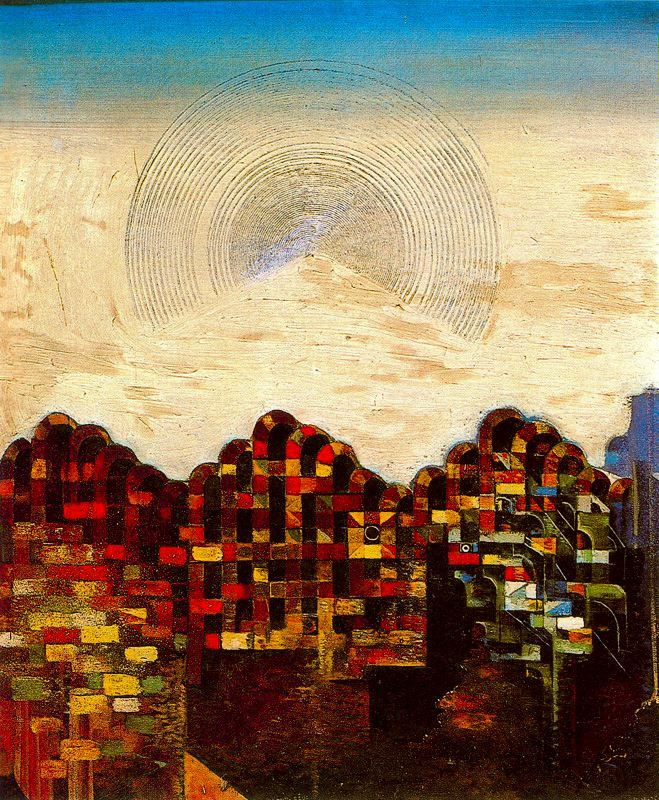Scan barcode
A review by glenncolerussell
Max Ernst: Beyond Painting by Ulrich Bischoff
5.0

The Eye of Silence
Max Ernst: Beyond Painting. Ninety pages of artistic dynamite with an extended essay by art historian Ulrich Bischoff. Part of the Taschen series with dozens of pages filled with Max Ernst art, the majority in color, this volume offers a solid foundation for anyone interested in the artist’s life and work. Below are a number of direct quotes from the essay along with my comments:
“Max Ernst, who grew up in a petty bourgeois home in the Rhineland experienced art and culture either as an occupation for affluent citizens on Sundays and holidays, or as the dry object of investigation in the hands of art history professors.” ----------- His stuffy home in a small German town was simply the outermost shell, and a thin shell at that; what is critically important is how, even at a young age, Max Ernst possessed an imagination on fire with vision and a boundless sense of freedom, as in, for example, "Oedipus Rex, 1922."
“Ernst’s main means of escape was to make use of objects having little to do with art and to employ an absolutely new technique.” ---------- That’s “objects having little to do with art” from a coarse, conventional perspective, that is, objects men and women stuck in lackluster, petty categories would never remotely consider as part of art. However, for one of the most dynamic creators of the 20th century, everything he came in contact with, large and small, no matter how mundane or commonplace, as if base metal in an alchemist’s laboratory, could be worked and transformed into artistic gold. Case in Point: "Fruit of a Long Experience."

“The young student was interested in obscure fields of study and had a predilection for all kinds of strange, offbeat topics. His attempt to break away, which was mainly made possible by his use of chance and the unconscious, was a successful one.” --------- Ha! “Offbeat” and “strange” are relative terms. For an artistic imagination on fire, working within the confines of any approach blocking off the power of chance, accident, unforeseen possibilities or the bizarre is judged as so much stuffy prattle. Below; "The Murdering Airplane"

“Like a magician, Max Ernst the artist transformed whatever he touched, whether sacred or profane.” ---------- I couldn’t imagine an artist having more disregard for his own tradition and culture, even when that tradition and culture touches on elements of the sacred, than his painting “Young Virgin Spanking the Infant Jesus In Front of Three Witnesses.”

“Throughout the whole of Max Ernst’s works, hands play an important part. For the deaf, they are the main means of communication and since his father was a teacher of the deaf, Max Ernst was confronted with sign language from an early age.” ---------- How about that – watching his father teach sign language made a profound impact on young Max. Such attention to the delicacy of hand and fingers can be seen in his “At the First Clear Word.”

“His search for a technical means of avoiding a direct application of paint runs through his entire work, as do his efforts to carry out the picture itself and its subject with elements non-related to art. . . . In “Paris Dream” he used a wire comb to scrape two-thirds of a circle into the final surface of beige-grey paint, revealing a layer of blue below.” ---------- What I particularly enjoy about this painting is the contrast between the bold colors set out in a checkerboard grid across three mountains and the pale lightness of the upper half, the circle (actually many circles within circles) having echoes of an astrologer’s symbol for sun.

“The methods Max Ernst developed to stay “beyond” the classical way of painting taught at art schools have had an enormous influence on international art: collage, assemblage, montage, grattage, and decalcomania are techniques which he either developed himself or made us of in such a way that they soon became acceptable to both art schools and society alike.” ---------- The mark of a great artist is to leave the field you work in expanded and renewed. By my eye, the two works below are examples of the profound influence Max Ernst has had on the visual arts: “Europe after the Rain II” and “Capricorn.” Capricorn has a special appeal since Max appears with his honey!



Photo of the Artist as a Young Man -- Max Ernst (1891-1976)